Spoon Fishing For Trout: Proven Guide Secrets
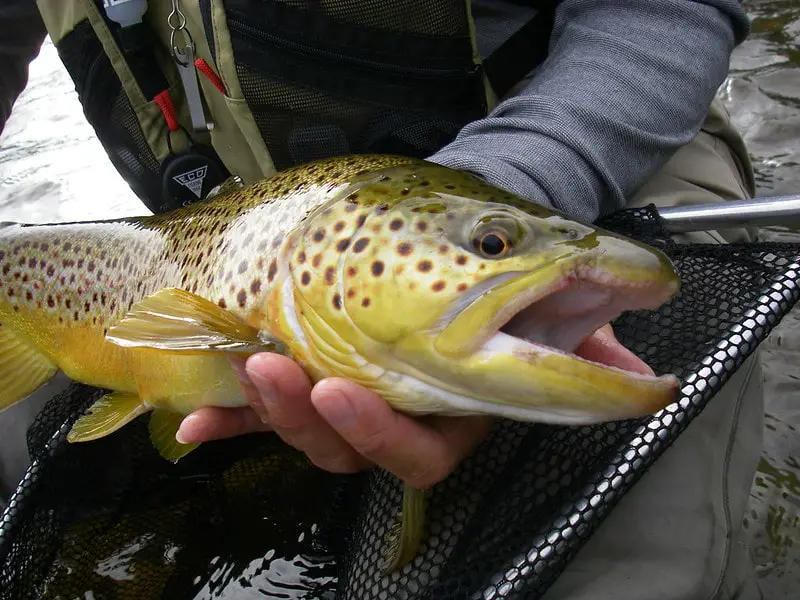
I’ve taught hundreds of anglers and some guides how to get better at spoon fishing for trout. I will share my insights, tips, and strategies for catching more trout on spoons.
Key Takeaways
- Spoon Types: Some spoons are more effective than others. I’ll reveal my most effective trout spoons and tell you why.
- Color and Size: I will change the color and size of my spoons based on the conditions, trout size, and trout activity level.
- Set-up: I discuss my favorite line and leader setup for using spoons.
- Presentation: This is the key to catching trout using spoons. I will discuss speed, depth, casting directions, how to cover the water more effectively to increase hook-ups by over 50%, and I will tell you how to trigger more strikes even with the spoon you are currently using.
Do Spoons Work For Trout?
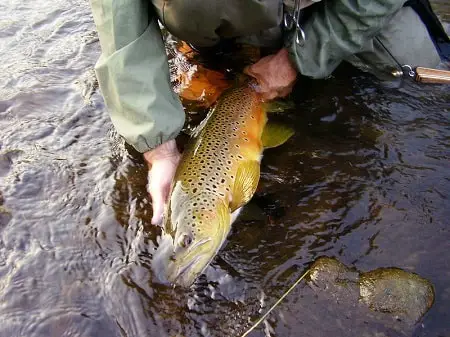
The effectiveness of spoons for all types of trout fishing is proven, and there is a reason veteran anglers and guides use spoons for trout.
When I am guiding trout using spoons, my approach depends on various factors such as river conditions, depth, water clarity, current speed, and the activity level of the trout.
Choosing the most suitable spoon and the type of action or retrieve based on these conditions is crucial for success.
A well-presented spoon resembles a baitfish, and this triggers a strike response due to the spoon’s lifelike appearance and movement.
Spoon Fishing For Trout Basics
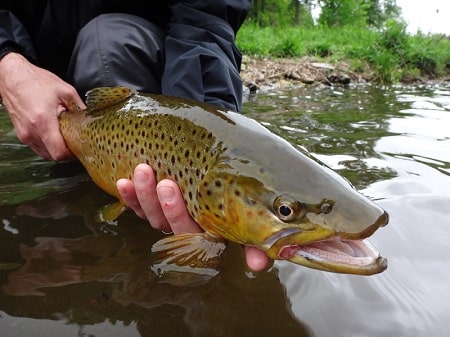
Spoon fishing involves using a lure called a spoon, and unlike many other trout lures, spoons possess the unique ability to flutter and flash, making them highly effective. The simplest method is casting the spoon out and reeling it back in.
I can make my retrieve more effective with some minor changes.
Not all spoons are suitable for trout fishing. The spoons I use are the correct size, color, and weight.
My favorite trout spoons described below generate a flash and vibration in the water, resembling distressed fish. I will also discuss how I impart more action to trigger more bites. They also cast well and perform effectively in moving water.
Best Spoons For Trout Fishing
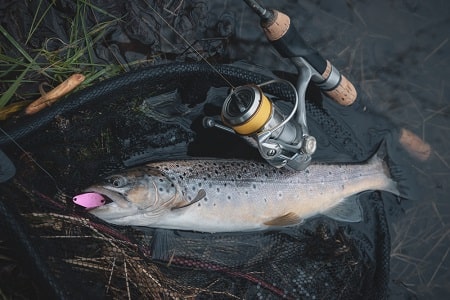
Selecting the appropriate spoon is crucial for successful trout fishing.
There are two types of trout spoons, but only one should be used:
Trolling Spoons: These lightweight spoons are designed specifically for trolling and are not really suitable for casting or fishing in currents. I have tried to make them work, but they just don’t work consistently.
Many trolling spoons are too light to cast effectively, do not sink well, and tend to spin out of control and pop out of the water in faster currents. It is advisable to avoid using these spoons in rivers and only use them when trolling for trout.
Casting Spoons: Heavier casting spoons offer superior casting distance due to their weight, they sink faster, exhibit an enticing wobble, and they perform well in moving currents. They are the preferred spoons for trout fishing and are commonly used by experienced guides.
The optimal size for trout casting spoons ranges from one to three inches in length, which closely resembles the baitfish sizes in the river. Even smaller trout under ten inches will still hit a three-inch spoon. Larger trout will hit a spoon up to five inches, and I usually have a few four-inch spoons to try.
Generally, I will use larger spoons in turbid or high-flow conditions and opt for smaller spoons in clear water or when targeting cautious fish in pools.
Here are some highly recommended spoons for trout fishing in rivers:
- ACME Tackle Little Cleo: The Little Cleo Spoon is widely regarded as one of the most popular trout spoons on the market. It performs exceptionally well in rivers and is suitable for casting off piers or shorelines of ponds and lakes. The 1.25 to three-inch size is ideal for most water bodies and long casts.
- Thomas Buoyant Spoons: This is one of the most effective spoons I use when guiding for trout. It comes in many good colors and is versatile and suitable for all three retrieval methods discussed below.
- Luhr Jensen Krocodile Spoons: The 1.25″ to 3.5-inch size is considered the best and most effective spoon for trout fishing. This spoon also has a lot of action and comes in many good colors.
- Mepps Little Wolf Spoon: This small spoon is a go-to choice for aggressive trout in most river sections. It is a highly rated and reliable spoon for stocked or wild trout.
- Thomas Colorado Spoon: This spoon is effective for trout in almost all water types and is one of the more popular spoons.
Don’t forget to check out more of my best spoons and other great trout lures.
Best Spoon Colors For Trout Fishing
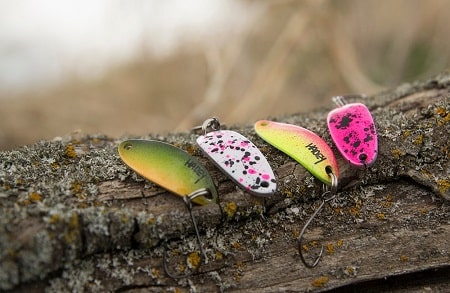
Choosing the right color of spoons can also influence the trout’s response.
I’m pretty sure I’ve caught trout on every color or color combination of spoon there is. However, there are some colors that remain consistent producers.
Any color combination with silver is generally good. Copper and gold can also be very good.
Other great colors for trout are:
- Yellow
- White
- black
- olive
- orange
- Chartreuse
One thing I have seen with trout is their color preference can change day-to-day.
For this reason, I will often fish a post twice or even three times in a row. I have cast every inch of a spot with one color and had no response from the trout, then I changed colors and it seemed like every trout in the pool smashed the new color.
Guide Tip: When changing spoon colors, go with drastic changes at first. This means if I use a white spoon with no results, I will go opposite and go with a black spoon. If that doesn’t work I’ll go slightly lighter than white, like maybe yellow or light greenish.
Silver, gold, or brightly colored spoons with reflective surfaces are generally very effective, as they create a flash that can be seen from a distance. Having a spoon with the above colors combined with some flash is often my first choice over dull-colored spoons.
Three Most Effective Spoon Fishing Techniques To Catch Trout
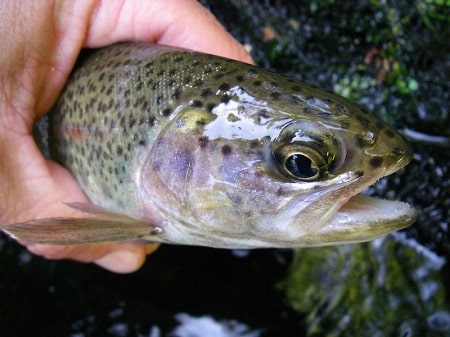
Method #1: The most commonly used technique involves simply casting the spoon into the river and then retrieving it straight in with a slow and steady retrieve.
Depending on the depth and speed of the river, I may need to allow the spoon to sink before starting the retrieve. I’ll discuss proper depth below.
Method #2: This technique is best suited for faster currents. Cast the spoon across and slightly downriver, allowing the current to swing the spoon across the pool without reeling at all. This “swing-style” method carries the spoon across the river and allows the spoon to wobble, which imitates natural movement and triggers trout response.
Method #3: This is a jigging-type method. With this method, cast the spoon out and across the river, allowing it to sink to the bottom. Lift the rod tip from waist height to a few feet over my head, then I lower the rod and repeat.
Three to four-foot movements of the rod tip are usually perfect. This jigging up and down motion creates a fluttering effect, resembling an injured baitfish, which triggers a strike response in large trout. This method is particularly effective near waterfalls, behind large obstacles, and in pocket water where trout tend to congregate.
I use these same methods when fishing spoons for steelhead and salmon in rivers.
How Fast To Reel A Spoon For Trout?
The speed at which I reel in the spoon depends on the spoon’s action, the current speed, and the trout’s activity level.
It is crucial to maintain a desirable side-to-side wobble and avoid excessive spinning, so I only reel in fast enough to get the spoon working well.
Generally, a slow to medium retrieve speed is most effective, but different spoons may require variations in retrieval speed. If the spoon spins or pops out on the surface, I know I am reeling too fast, or the current speed combined with me reeling is too fast for the spoon.
Inactive or neutral trout often require a slower speed and a more erratic retrieve. More aggressive trout will hit faster-moving spoons and a straight retrieve. Aggressive trout will also hit a slower erratic retrieve, which is why I use this type of retrieve the most.
How Deep To Fish Spoons For Trout?
Determining the appropriate depth to fish spoons for trout in bigger and deeper rivers is vital. In most cases, the trout are found close to the bottom, but that does not mean my spoon should be dragging along the bottom, because it shouldn’t be.
To target trout effectively, I aim to keep the spoon approximately two to three feet above the trout’s heads. In very clear water or when the trout are aggressive, adjustments may be necessary, and I may be fine to target depths of five to six feet above their heads.
The goal is to keep my spoon within their strike zone since trout prefer to feed upwards. Keeping the spoon off the bottom also helps minimize snags.
In my experience, getting the spoon closer to the trout increases the likelihood of provoking a strike. Therefore, the closer the spoon is to the trout, the better.
However, it can be challenging to determine the exact depth or height at which the spoon should be presented in deeper water, especially if I don’t know how deep the water is and at what level the trout are holding or feeding. I will discuss my tactics for finding the right depth below.
When fishing with spoons, there are two approaches I use for positioning the lure in the water column. Most of the time, trout will be close to the bottom, but there are instances where they may be suspended.
Fishing Spoons High for Trout
In shallower rivers, lakes, or ponds, or areas less than six feet deep, I can start reeling in the spoon as soon as it hits the water to keep it higher in the water column. Sometimes, the spoon may only be a foot or two below the surface, which can be deep enough if the spot is five feet deep or less, or if the trout are looking up and feeding high.
In shallow water, I may need to keep my rod tip high to keep the spoon elevated and prevent it from hitting the bottom. The height of my rod tip will depend on the current speed, spoon weight, and the desired depths.
If I find that the spoon is still hitting the bottom with a waist-high rod tip, I elevate it to head height or slightly higher. In my experience, lifting the rod tip over my head is rarely necessary.
Fishing Spoons Deep For Trout
To achieve greater depths, I cast straight across or slightly upriver, allowing the spoon to sink before starting the retrieve. The longer I wait and let the spoon sink, the deeper it will go.
During the retrieve, the spoon may start to rise, but a slower retrieval speed will help maintain its depth. I can also keep the rod tip low, even submerging it below the water’s surface, to maximize depth and prevent the spoon from rising.
If I consistently find the spoon bumping the bottom, it indicates that I am fishing too deep. To adjust, I will abruptly lift the rod tip by three to six feet, which should raise the spoon accordingly. Keeping the rod tip elevated will help maintain the spoon at a higher level.
It’s important to note that trout may be close to the bottom or suspended a few feet off it, and this will affect their visibility and catchability, especially if the spoon is below them.
Covering All Levels of the Water Column
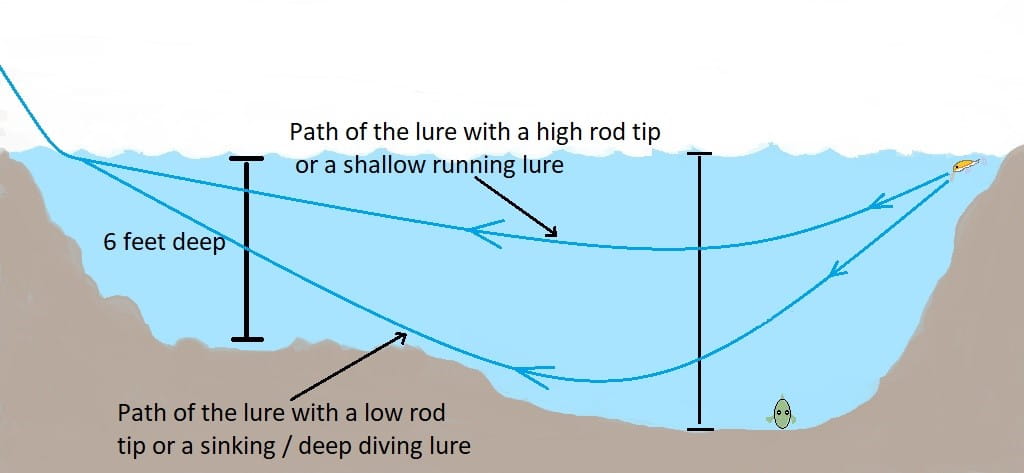
To effectively cover the water column, I use a systematic approach rather than randomly casting in all directions.
My recommended method for fishing a river and covering all parts of the water column involves starting with the first cast near the surface and gradually getting deeper with each consecutive cast until I hot fish or hit bottom.
First Cast: I reel immediately as it hits the water and reel slowly to cover the top part of the water column.
Second Cast: I will cast to the exact same spot as the first cast, allowing the spoon to sink three to six feet (three to six seconds). Then I lower my rod tip to or just below the water’s surface to effectively target the middle or lower part of the water column. A low rod tip or a rod tip below the surface will keep the spoon deep.
Third Cast: If I haven’t had a bite or hit the bottom on the first two casts, I cast back to the exact same spot and let the spoon sink even longer or all the way to the bottom before starting the retrieval. Once it reaches the bottom, I lift the rod tip three to six feet to suspend the spoon above the bottom.
I know when I’m on the bottom when the line on the surface goes slack.
Repeat: I cast three to five feet down the river and repeat the process. I pay close attention to any bites or bumps during the three casts, as they can provide valuable information about the fish’s location. This allows me to eliminate ineffective casts and focus on the level at which the trout are actively feeding or holding.
Often, I find that the most productive bites occur on the third or subsequent casts, which gives me a better understanding of the fish’s depth preferences.
By adjusting the depth and gradually presenting the spoon lower and lower each time and in front of the trout with each cast, I can maximize my chances of enticing a strike from trout at all levels of the water column.
It’s important to note that achieving the correct depth and covering the water effectively requires patience and observation.
While some anglers may rush through a spot within a few minutes, I often spend an hour or more in the same area and often, I catch fish when others don’t.
Angler Position and Casting Direction
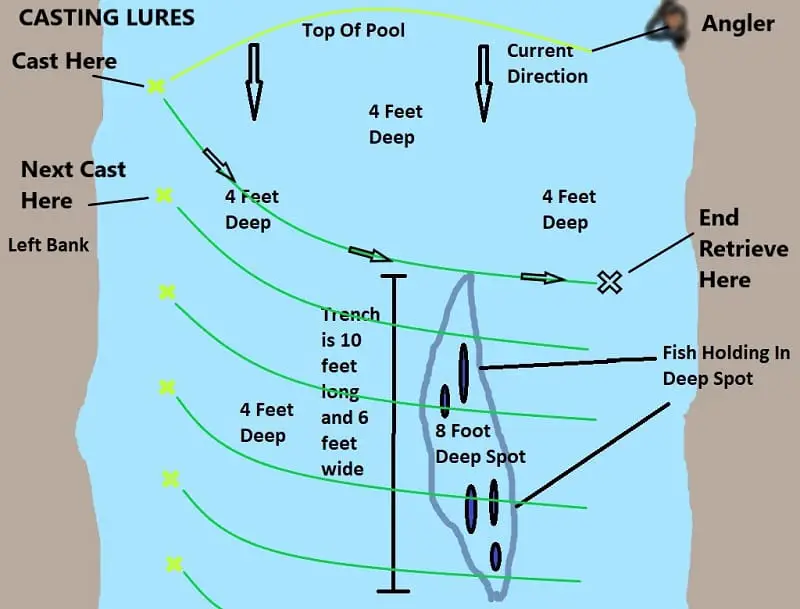
When casting a spoon for trout in a river, I have found that casting straight across the river or slightly downriver yields better results than casting upriver or straight downriver.
Casting upriver and retrieving downriver can sometimes startle the fish or make it more challenging for them to grab the lure.
In contrast, a spoon fluttering broadside and moving sideways across the river presents an easier and more enticing target for trout. Therefore, an across-river cast with a sideways retrieve is generally the most effective approach.
Covering The Water
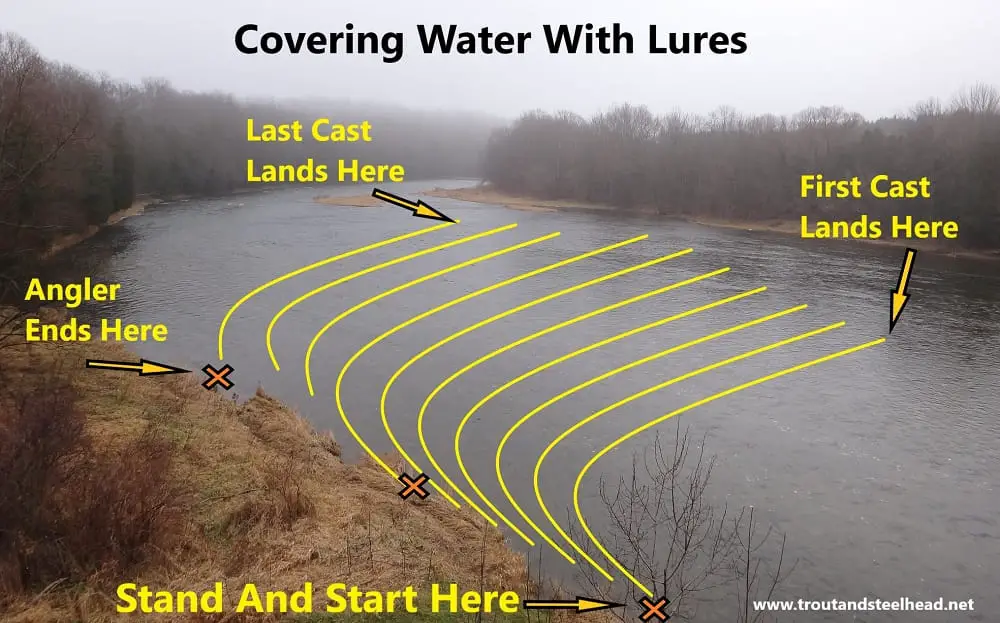
Properly covering the water is essential when spoon fishing in a river or lake. A lake is simply fan-casting. However, I do not recommend that in a river.
Instead of randomly casting or fanning in different directions, it’s best to adopt a methodical approach that covers the water from top to bottom.
This is a common oversight among anglers and can significantly impact their success in catching trout using various methods.
To achieve good coverage and to ensure I don’t miss any fish, I start my first retrieve at the top of the target area and gradually moving downward by three to five feet with each subsequent cast.
Instead of casting down three to five feet, I cast in the exact same direction each and every time, and I move my body downriver three to five feet before each cast.
Three to five-foot increments ensure that every trout in the vicinity has an opportunity to see my spoon, leaving no gaps. With each cast, the spoon is presented slightly lower and closer to the trout, increasing the likelihood of enticing a strike.
I’ve watched my clients fish an entire spot with their “random casting method” that they claim works for them, and although it works sometimes, having them fish the spot again using my “systematic coverage method” usually ends up being far more effective with a lot more trout hooked.
Adapting to River Conditions for Spoon Selection and Technique
Adapting my fishing approach to suit the specific river conditions is vital. I adjust based on factors such as depth, current speed, water clarity, the presence of structures like rocks and logs, and the width of the river, because these all influence the behavior and holding spots of trout.
Fishing With Spoons In Clear Water
In clear water conditions, I do not need to get my lure as close to the trout and have the advantage of running spoons up to six feet away from a trout, while still having good success.
Casting further apart allows me to spread out my casts and cover the water faster, which at the end of the day means I put my lure in front of a lot more trout.
However, exercise caution in shallow, clear water, as trout can be easily spooked by the splash of the spoon or its close proximity. To mitigate this, opt for smaller, less flashy spoons, cast them farther away from the fish or as close to the bank as possible, and retrieve them at a slower pace to remain inconspicuous.
Most of the time, I avoid landing my spoon directly on top of fish or in the middle of the pool. Instead, I aim to cast as close to the far bank as possible and draw the spoon across and in front of the trout to avoid startling them in clear water.
It’s also important that I stay quiet and that I stay out of the trout’s line of sight, which means staying out of the water if possible, staying low, and casting from a further distance whenever possible.
Dirty or Stained Water Spoon Fishing
In dirtier or stained water, where visibility is reduced, it becomes crucial to bring the spoon closer to the trout, ideally within a foot or two. I will slow down my retrieve to accommodate the limited visibility.
The jigging retrieve technique proves highly effective in these conditions, as it helps trout locate the lure despite the reduced visibility.
Pro Tip: If the water is exceptionally dirty, I will use a noisier lure such as an in-line spinner like a Vibax Spinner or a crankbait with a rattle. The added noise of the lure assists the trout in locating and striking the lure when their vision is compromised.
In un-clear water situations, the other option is to use larger spoons or lures with bright chartreuse colors to enhance their visibility in the murky water.
Adapting to Fast and Slow Water Conditions
Tailoring my approach to the water speed is crucial in trout spoon fishing. Consider the following:
Fast Water Methods and Tips
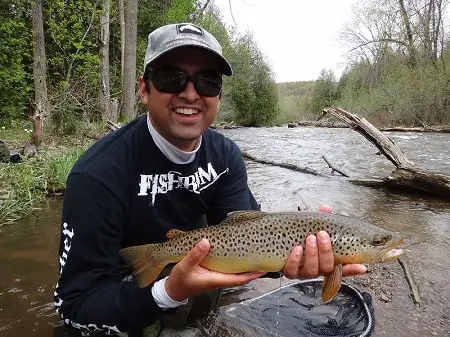
When fishing in faster currents, employ the swing method so the spoon moves slower and the spoon’s action is best.
Allow the spoon to move slowly with the current, avoiding rapid reeling that may cause the spoon to spin or become too difficult for the fish to detect and grab.
Slow Water Methods and Tips
In slower water, I opt for a slow to medium-speed retrieve or the jigging technique. The swing method is less effective since the slow current won’t facilitate the desired wobbling motion of the spoon, and it may cause the spoon to hit and drag along the riverbed too much.
Tight Lines,
Graham
